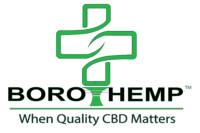A Certificate of Analysis or Authenticity or (COA) is a document provided by a third-party laboratory that analyzes and verifies the contents of a CBD or hemp product. Common lab reports for Boro Hemp Co originate from ACS Labs or SD Pharm Labs. These documents contain important information about the product’s composition, potency, and safety. Everything from THC levels, cannabinoids, pesticides and of course potency will be tested for and categorized within a Certificate of Authenticity. Here’s a guide on how to read a COA for CBD and hemp derived products:
- Laboratory Information: Look for the name, address, and contact information of the laboratory that conducted the analysis. Ensure that it’s from an accredited and independent third-party lab, not affiliated directly with a manufacturer such as Boro Hemp Co. This is to ensure any given test can be trusted without any potential bias.
- Product Information: Check if the COA matches the product you have. For example, Boro Hemp will have differing COAs for a product that comes in a variety of different mgs such as tinctures. Verify the batch or lot number mentioned on the COA against the product packaging to ensure they correspond.
- Cannabinoid Profile: The COA should display a list of cannabinoids present in the product, such as CBD (cannabidiol), THC (tetrahydrocannabinol), CBG (cannabigerol), CBN (cannabinol), etc. Pay attention to the concentration of CBD and THC, ensuring they fall within legal limits (usually <0.3% THC for hemp-derived CBD products on a dry-weight basis).
- Terpene Profile: Some COAs include terpene analysis. Terpenes are aromatic compounds that contribute to the flavor and potential effects of the product. This section will list various terpenes detected and their concentrations. You will see these most commonly in our products such as tinctures and several cartridges.
- Heavy Metals: Check for the presence of heavy metals like lead, arsenic, cadmium, and mercury. The COA should indicate if these metals are within safe limits defined by regulatory standards.
- Pesticides and Herbicides: Ensure the COA shows the absence or allowable limits of pesticides and herbicides. This is crucial for ensuring the product’s safety.
- Microbial Analysis: Look for microbial testing results for bacteria, molds, yeast, and other pathogens. Safe levels of these contaminants should be specified or indicated as “pass.”
- Residual Solvents: If the CBD product was extracted using solvents, the COA should confirm that residual solvents are within safe limits.
- Date of Testing and Report: Check the date when the sample was tested and when the report was issued. A recent report ensures the information is current and relevant. COAs are valid for a finished product a year after the initial testing date.
- Additional Information: Some COAs might include additional information like the testing methods used, the detection limit of the tests, and any notes relevant to the analysis.
Reading and understanding a COA is crucial in ensuring the quality, safety, and potency of CBD and hemp products. If you have any doubts or concerns about the COA, consider reaching out to the manufacturer or the testing laboratory for clarification. Additionally, reputable brands often make their COAs readily available to customers, reflecting their commitment to transparency and quality. Here at Boro Hemp, we do just that by providing hyperlinks on each product page directly to the relevant COA for your ease of access and peace of mind!
If you are having trouble reading a COA of ours, do not hesitate to contact us and we will provide clarification as needed!
